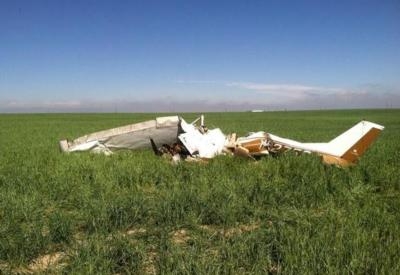Pilot, Passenger Aboard Cessna 150 Snapping Flash Photos At Night
The two people board a Cessna 150 that went down on May 31 last year in Watkins, CO were apparently taking "selfies" using flash photography during a night flight in IFR conditions.

The end result was two fatal injuries when the plane went down, according to the NTSB's probable cause report on the accident.
While the board did not entirely blame the accident on the cockpit activity, it said it was a "contributing" factor in the loss-of-control accident.
According to the report, the airplane departed on the local night flight in instrument flight rules conditions with 7 miles visibility and overcast clouds at 300 ft above ground level (agl). Radar data showed that the airplane departed the runway, made one flight around the traffic pattern, and landed 6 minutes later.
The airplane departed again to the west, did not remain in the traffic pattern, and reached an altitude of 740 ft agl. The airplane made a left turn, which tightened as the airplane descended about 1,900 ft per minute. The airplane impacted a field and bounced one time before it came to rest upright.
A GoPro camera was found near the wreckage, and the files were recovered. Based on the available information, it is likely that the GoPro files were recorded on May 30 and May 31, 2014, with the final GoPro file recorded during the 6-minute flight in the traffic pattern. The accident flight was not recorded. The GoPro recordings revealed that the pilot and various passengers were taking self-photographs with their cell phones and, during the night flight, using the camera’s flash function during the takeoff roll, initial climb, and flight in the traffic pattern.
A postaccident examination of the airplane did not reveal any preimpact anomalies that would have precluded normal operation. Based on the wreckage distribution, which was consistent with a high-speed impact, and the degraded visual reference conditions, it is likely that the pilot experienced spatial disorientation and lost control of the airplane. The evidence is consistent with an aerodynamic stall and subsequent spin into terrain.
Based on the evidence of cell phone use during low-altitude maneuvering, including the flight immediately before the accident flight, it is likely that cell phone use during the accident flight distracted the pilot and contributed to the development of spatial disorientation and subsequent loss of control. A review of the pilot’s logbooks did not show that he met the currency requirements for flight in instrument meteorological conditions or night flight with passengers.
The National Transportation Safety Board determines the probable cause(s) of this accident to be the pilot’s loss of control and subsequent aerodynamic stall due to spatial disorientation in night instrument meteorological conditions. Contributing to the accident was the pilot’s distraction due to his cell phone use while maneuvering at low-altitude.
(Image provided by the Adams County, CO Sheriff's Office)
 ANN's Daily Aero-Term (04.26.24): DETRESFA (Distress Phrase)
ANN's Daily Aero-Term (04.26.24): DETRESFA (Distress Phrase) Aero-News: Quote of the Day (04.26.24)
Aero-News: Quote of the Day (04.26.24) ANN's Daily Aero-Term (04.27.24): Direct
ANN's Daily Aero-Term (04.27.24): Direct ANN's Daily Aero-Linx (04.27.24)
ANN's Daily Aero-Linx (04.27.24) Aero-News: Quote of the Day (04.27.24)
Aero-News: Quote of the Day (04.27.24)



